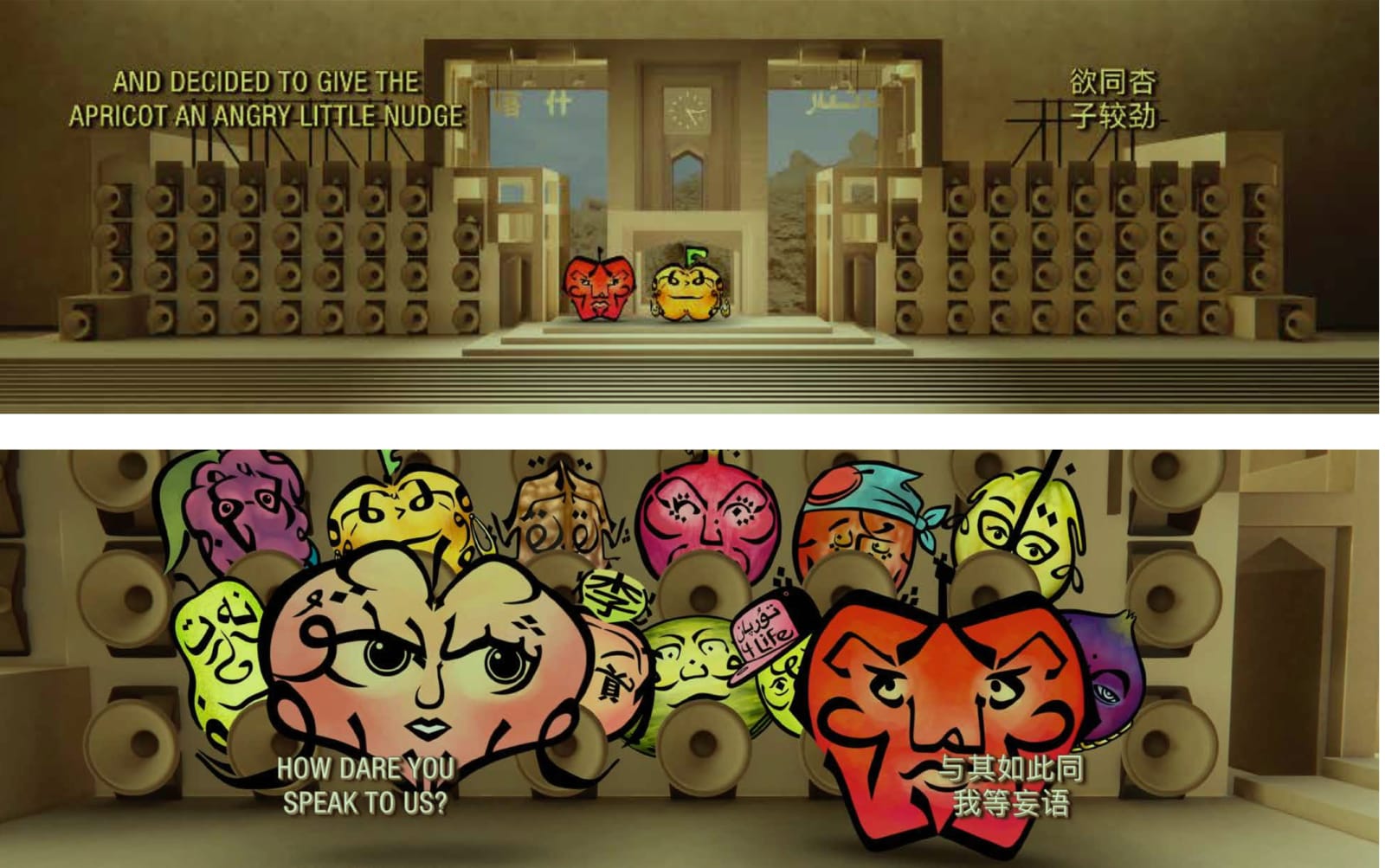Slavs and Tatars
The Contest of the Fruits, 2021
1 channel video, animation
07min 18sec (loop)
Ed. 1 of 3 (+2AP)
07min 18sec (loop)
Ed. 1 of 3 (+2AP)
Further images
The Contest of the Fruits, Slavs and Tatars’ first animated film, takes a satirical 19th century Uyghur poem as a starting point for investigations of language, politics, religion, humor, resilience...
The Contest of the Fruits, Slavs and Tatars’ first animated film, takes a satirical 19th century Uyghur poem as a starting point for investigations of language, politics, religion, humor, resilience and resistance, in the form of a rap battle between various fruits.
The original poem, The Contest of the Fruits, written in verse and equipped with proverbs and aphorisms, stages a form of verbal dispute (or munāẓara) and has been translated into English for the first time by Gunnar Jarring in 1936. Nash Tarr, a rapper hailing from the Uyghur diaspora, delivers a performance of the original soundtrack of Slavs and Tatars’ animated movie, where the words take shape within the dynamic context of a rap battle, with pop, trap and maqam elements, mixed by Polish musician Lubomir Grzelak. Thirteen fruits, from the mulberry to the pomegranate, the quince and the jujube, engage in an ironic oratorical joust. The fruit's individual physiognomy is shaped after its respective Uyghur name, rendered in Arabic calligraphy. The film reveals the richness of Uyghur culture, syncretic, linguistic and ethnographic heritage that make up Uyghur identity.
The Contest of the Fruits was developed by the collective during their residency at The Hurford Center for the Arts and Humanities, Haverford College and The Pew Center for Arts & Heritage, Philadelphia (US) in 2021. It has been shown at Basement Roma (2023), Centre Pompidou, Metz (2022), and Cantor Fitzgerald Gallery, Haverford (2021).
The original poem, The Contest of the Fruits, written in verse and equipped with proverbs and aphorisms, stages a form of verbal dispute (or munāẓara) and has been translated into English for the first time by Gunnar Jarring in 1936. Nash Tarr, a rapper hailing from the Uyghur diaspora, delivers a performance of the original soundtrack of Slavs and Tatars’ animated movie, where the words take shape within the dynamic context of a rap battle, with pop, trap and maqam elements, mixed by Polish musician Lubomir Grzelak. Thirteen fruits, from the mulberry to the pomegranate, the quince and the jujube, engage in an ironic oratorical joust. The fruit's individual physiognomy is shaped after its respective Uyghur name, rendered in Arabic calligraphy. The film reveals the richness of Uyghur culture, syncretic, linguistic and ethnographic heritage that make up Uyghur identity.
The Contest of the Fruits was developed by the collective during their residency at The Hurford Center for the Arts and Humanities, Haverford College and The Pew Center for Arts & Heritage, Philadelphia (US) in 2021. It has been shown at Basement Roma (2023), Centre Pompidou, Metz (2022), and Cantor Fitzgerald Gallery, Haverford (2021).
Exhibitions
2024, Kraupa–Tuskany Zeidler, Berlin (DE)2023, Basement Roma (IT)
2022, Centre Pompidou, Metz (FR)
2021, Cantor Fitzgerald Gallery, Haverford (US)


